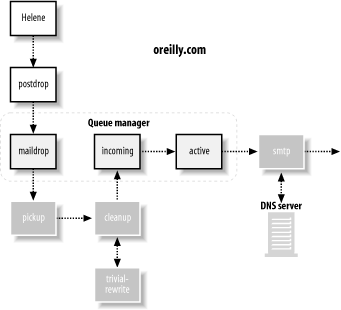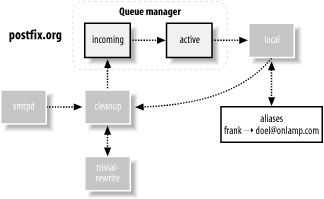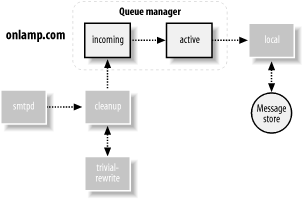Tracing a Message Through Postfix
Let's follow a typical message through the Postfix system. Figure 3-4, Figure 3-5, and Figure 3-6 illustrate the process as the message goes from the originating system to a destination MTA, which, in turn, forwards it to the final MTA, where it is held until the user is ready to read it. In Figure 3-4, Helene (helene@oreilly.com) wants to send a message to Frank (frank@postfix.org). Helene has an account on a system that runs Postfix. Her email client lets her compose the message, and then it calls the Postfix sendmail command to send it. The Postfix sendmail command receives the message from Helene's email software and deposits it into the maildrop directory. The pickup daemon then retrieves the message, performs its sanity checks, and feeds the message to the cleanup daemon, which performs the final processing on the new message. If Helene's email client did not include a From: address, or did not use a fully-qualified hostname in the address, cleanup makes the necessary fixes to the message.
Figure 3-4. Tracing message delivery 1

Once finished, cleanup places the message into the incoming queue and notifies the queue manager that a new message is ready to be delivered. If the queue manager is ready to process new messages, it moves the message into the active queue. Because this message is destined for a user on an outside system, the queue manager has to alert the smtp agent to handle the delivery of the message.
The smtp agent uses DNS (see Chapter 6) to get a list of email systems that can accept mail for the domain postfix.org. The smtp delivery agent selects the most preferred MX host from the list and contacts it to deliver Helene's message.
Figure 3-5 shows Frank's email server at postfix.org also running Postfix, although the system could be using any other standards-compliant MTA. The Postfix smtpd on Frank's server takes the message from Helene's smtp delivery agent. After the smtpd daemon verifies that it should, in fact, accept this message, it passes the message through to the cleanup daemon, which performs its checks before depositing the message into the incoming queue.
Figure 3-5. Tracing message delivery 2

The queue manager moves the message to the active queue, performs its processing, and determines that it should call on the local agent to make the final delivery of the message. The local delivery agent finds that frank is an alias and resubmits the message through the cleanup daemon for delivery to the new address.
Both cleanup and the queue manager call upon the trivial-rewrite daemon when processing messages. trivial-rewrite helps with converting email addresses to a standard format and determining the transport type and next hop for delivery.
When a new message has to be delivered to another network, the queue manager calls on smtp, which checks the DNS for mail servers that can accept mail for the domain onlamp.com. In Figure 3-6, the MTA at the onlamp.com system (once again by a happy coincidence, it's a Postfix system) eventually hands the message to the local delivery agent, which deposits it into the message store on that system. At this point Postfix has finished its job. Frank can now read the message using his own email client, which might pull it directly from the local message store or might use another protocol, such as POP or IMAP, to get the message for him to read.
Figure 3-6. Tracing message delivery 3

There are several variations that might have occurred in our simple example. Perhaps the message could not be delivered at any step for some temporary reason, in which case the delivery agent alerts the queue manager, which places the message into the deferred queue and attempts another delivery at a later time. Another possibility is that doel is not an actual account on the system but an account in an IMAP email system. In this case, the queue manager might deliver the message through the lmtp agent or via a specialized command configured through the pipe delivery agent.
There are many variations and potential complications for Postfix to deal with. Fortunately, the architecture is robust enough to deal with nearly all situations, and flexible enough to easily accommodate changes in the future.
Introduction
- Introduction
- Postfix Origins and Philosophy
- Email and the Internet
- The Role of Postfix
- Postfix Security
- Additional Information and How to Obtain Postfix
Prerequisites
Postfix Architecture
- Postfix Architecture
- Postfix Components
- How Messages Enter the Postfix System
- The Postfix Queue
- Mail Delivery
- Tracing a Message Through Postfix
General Configuration and Administration
- General Configuration and Administration
- Starting Postfix the First Time
- Configuration Files
- Important Configuration Considerations
- Administration
- master.cf
- Receiving Limits
- Rewriting Addresses
- chroot
- Documentation
Queue Management
Email and DNS
Local Delivery and POP/IMAP
- Local Delivery and POP/IMAP
- Postfix Delivery Transports
- Message Store Formats
- Local Delivery
- POP and IMAP
- Local Mail Transfer Protocol
Hosting Multiple Domains
- Hosting Multiple Domains
- Shared Domains with System Accounts
- Separate Domains with System Accounts
- Separate Domains with Virtual Accounts
- Separate Message Store
- Delivery to Commands
Mail Relaying
- Mail Relaying
- Backup MX
- Transport Maps
- Inbound Mail Gateway
- Outbound Mail Relay
- UUCP, Fax, and Other Deliveries
Mailing Lists
Blocking Unsolicited Bulk Email
- Blocking Unsolicited Bulk Email
- The Nature of Spam
- The Problem of Spam
- Open Relays
- Spam Detection
- Anti-Spam Actions
- Postfix Configuration
- Client-Detection Rules
- Strict Syntax Parameters
- Content-Checking
- Customized Restriction Classes
- Postfix Anti-Spam Example
SASL Authentication
- SASL Authentication
- SASL Overview
- Postfix and SASL
- Configuring Postfix for SASL
- Testing Your Authentication Configuration
- SMTP Client Authentication
Transport Layer Security
Content Filtering
External Databases
Appendix A. Configuration Parameters
Appendix B. Postfix Commands
Appendix C. Compiling and Installing Postfix
- Appendix C. Compiling and Installing Postfix
- C.1. Obtaining Postfix
- C.2. Postfix Compiling Primer
- C.3. Building Postfix
- C.4. Installation
- C.5. Compiling Add-on Packages
- C.6. Common Problems
- C.7. Wrapping Things Up
Appendix D. Frequently Asked Questions
EAN: 2147483647
Pages: 130
